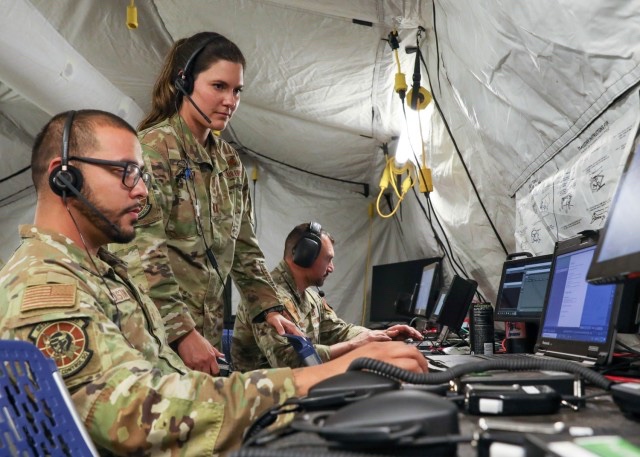
CAMP PENDLETON, Calif. — At Project Convergence 2022, a large-scale, all-service experiment focused on evaluating innovative warfighting capabilities, lightweight command posts are illustrating how the U.S. military will enable nimble tactical operations on future battlefields.
Staffed by Airmen and Soldiers, the command post prototypes, referred to in the exercise as Tactical Operations Centers — Light, are significantly smaller and more agile than previously fielded versions.
The U.S. Air Force provided the equipment that forms the centers — high-powered, ultra-secure servers and commercially compatible computing systems — following three years of iterative research and development with industry partners.
The effort originated from a desire to transform legacy Control and Reporting Centers (CRCs), which have for years served as the Air Force’s mobile command and control (C2) and communications radar centers in theater, while advancing distributed tactical C2 objectives.
While reliable and effective, CRCs are also heavy and large, making rapid relocation difficult.
“We’re just too big and clunky,” said Douglas Lomheim, deputy chief of Ground Battle Management Systems at the U.S. Air Force Air Combat Command.
The Air Force’s exploration of viable miniaturized alternatives has yielded multiple potential options for command centers with smaller footprints.
One option undergoing evaluation at Project Convergence 22 is the Modular Detachment Kit, which utilizes scalable, decentralized C2 and sensor nodes and remote voice and data communications to deliver a common operating picture.
The modular nature of the kit means warfighters can select and deploy only the capabilities they need for a specific operational environment, minimizing costs and optimizing transport efficiency.
A smaller, less detectable C2 center is also inherently a more survivable one, Lomheim explained, with the ability to establish a more dispersed setup, further improving operator safety.
The Modular Detachment Kit also leverages new technologies and open architecture framework to support increased data storage and an expanded range of data and communications assets, allowing for easier connection and integration with sister services and multinational partners.
“Anything that’s developed for [joint all-domain command and control] can easily be loaded on here,” Lomheim said, referring to the U.S. Department of Defense’s development of Joint All-Domain Command and Control.
The system’s diverse set of modules, which address various needs for C2, datalink, radio, radar and multi-mission operations capabilities, and ability to track air, land, maritime, space and cyber resources, make it well-equipped for deployment to a challenging, multi-domain environment – the precise type of environment that Project Convergence 22 is replicating.
As part of the experiment, the Tactical Operations Centers — Light are tracking simulated threats as well as real aircraft movements, conducting activities ranging from coordinating with Tactical Air Control Party members in the field to monitoring possible defense maneuvers by the Army’s Patriot Missile System and the Navy’s Aegis Weapon System.
“It’s a brand-new perspective,” said Air National Guardsman Master Sgt. David Joseph, Weapons Director with the 255th Air Control Squadron based in Gulfport, Mississippi.
“We’re kind of in that crawl, walk phase of it, mostly trying to just get a sense of how we’re all going to connect and how we’re actually going to integrate into the systems that we’re all using,” Joseph said, noting that the shift from having roughly 100 personnel manning a CRC to only a handful operating the new command post model has been interesting to see.
The dynamism of the system is also intriguing. “We’re essentially safeguarding both Air Force and Naval assets and airspace management,” said Staff Sgt. Caleb Kennedy of the Air Force’s 20th Air Support Operations Squadron at Fort Drum, New York.
Through the ongoing Project Convergence 2022 experiment, Joseph, Kennedy and fellow Airmen have worked alongside Army Air Defense Artillery Fire Control Officers and other specialists to amplify situational understanding and practice pairing sensors with the most appropriate shooters, harnessing the system’s potential to deliver improved battlespace awareness, decision advantage and information dominance.
“We’re learning a lot of additional roles, we’re seeing those roles and responsibilities meld together, and actually it’s really enhancing our team efficiency,” Kennedy said, adding that the experience is helping to build participants’ subject matter expertise on air power and execution.
“We’re showing that we’re able to connect in with any system that is provided from our other, sister services,” Kennedy said of the Air Force’s participation in Project Convergence 2022. “Having us here is giving just one more way to expedite battlefield effects and ultimately safe airspace management.”
“The further we go into the future, we’re going to be fighting a war a whole different way than we’re fighting it today,” Joseph said.
“I feel like this exercise here is going to be the baseline for how we go about fighting that war.”
By Maureena Thompson, Army Futures Command


How are these dudes in the photo rocking facial hair?